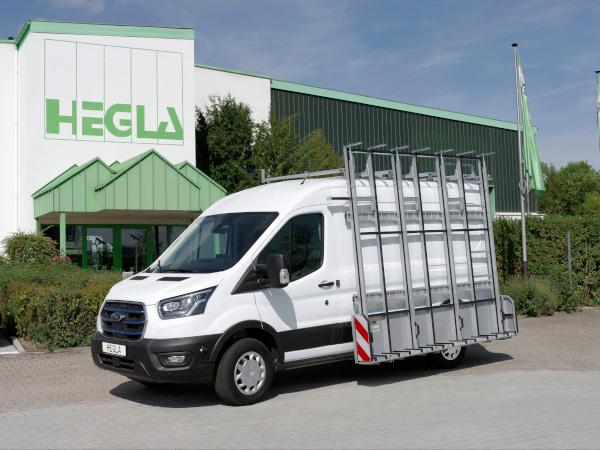
Date: 22 July 2024
What is the current situation now that state subsidies for electric cars have been cancelled?
Demand for commercial electric vehicles has stabilised and electric vehicles are now an integral part of many companies’ vehicle fleets. Customers have had positive experiences and we equip a good number of electric transporters in the 2.8 to 3.5-tonne segment with our racks for transporting glass and windows. The abolition of state subsidies has brought with it a number of challenges, but manufacturers have responded by increasing their discounts to lower the barrier to the purchase price. It goes without saying that an electric vehicle is not an option for every business, application and delivery radius. Unlike a few years ago, however, there is now a larger selection of electric vehicles available with corresponding options.
Why is the trend and demand still primarily restricted to commercial electric vehicles in the 2.8 to 3.5-tonne range?
Traditionally, vans in this weight class are widely used by our customers, the industry and related trade businesses. This is compounded by the fact that these commercial e-vehicles have a good mix of load volume, total weight and range. We fit a weight-optimised rack system to these e-vehicles to keep the load low. The vans are significantly more efficient than electric trucks, for example, as the latter are simply too heavy in terms of overall weight and therefore have a small range. An electric truck can be worthwhile if a company always drives the same routes and there is a charging facility at the start and end of the trip. For small and medium-sized glazier businesses, however, this is out of the question in purely practical terms, as the delivery journeys and transport routes, as well as the purposes for which the vehicles are used, vary too greatly. These companies need a reliable vehicle with sufficient range. We recommend at least 300 kilometres, which provides the necessary flexibility even with a heavy load and in winter.

In your opinion, what are the main reasons for trade businesses to buy a commercial electric vehicle?
It has a lot to do with sustainability. Companies see the switch to e-vehicles not only as a chance to reduce operating costs or utilise their own solar power; it is also an opportunity to send a strong signal in terms of environmental protection and sustainability. This strengthens the company’s image and sometimes wins the trust and interest of customers.
For many, the government subsidy with the environmental bonus and the simultaneous enormous rise in fuel prices represented an impetus to buy an e-vehicle. In the meantime, the hurdle of range has been lowered, as development has progressed and battery capacities have improved significantly, so that today’s electric vans have a much higher performance than their predecessors. And the charging infrastructure has improved. There are also practical reasons for owning an electric vehicle: businesses operating in large cities and having to make deliveries in city centres are allowed to drive their electric vehicles into environmental zones, where a diesel vehicle would not be able to enter so easily. This also confirms the demand for medium-sized vehicle models, such as vans and sprinters, as they are easier to drive and more manoeuvrable than trucks in city traffic.

What needs to be considered when equipping a commercial electric vehicle? What different equipment does a commercial electric vehicle need?
Before the conversion, it is important to precisely determine and define the intended use of the vehicle. We always fit a weight-optimised aluminium rack with torsion-resistant profiles as standard. Heavy and oversized goods can be stored here at body height for ease of use. If private or long journeys without transport take place on the exterior rack, we recommend the quickly detachable version. This rack is easy to dismantle, reducing the weight and width. This also makes vehicle maintenance easier and the attachment can be used on various vans. If a business needs additional or separate storage areas, an interior rack is a worthwhile consideration. It can also be used to carry structural elements that need to be protected against rain or damage from stones. A tool cabinet is also very practical, bringing order and structure to the interior of the assembly vehicle and making a good first impression on the customer.

The HEGLA Group is travelling to Glasstec 2024 and will be presenting its numerous innovations in Hall 14, Stand A60. At the special HEGLA Fahrzeugbau stand in Hall 10, Stand C79, you will find our glass transport attachments and everything to do with perfect glass transport.
 600450
600450









Add new comment